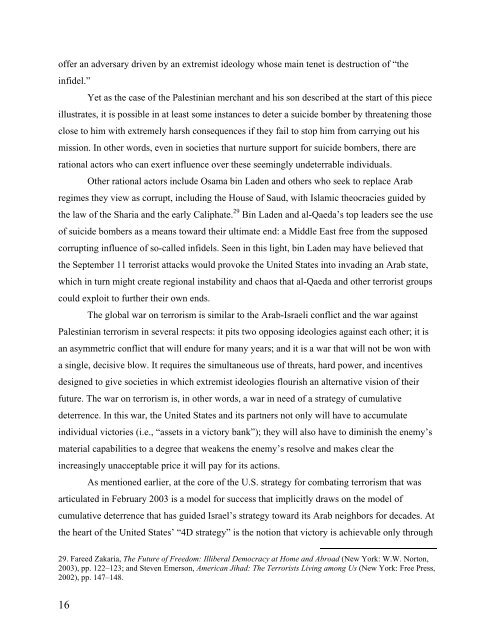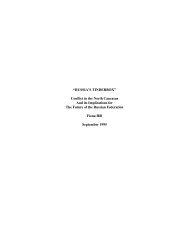Cumulative Deterrence and it's implementations to the War against ...
Cumulative Deterrence and it's implementations to the War against ...
Cumulative Deterrence and it's implementations to the War against ...
You also want an ePaper? Increase the reach of your titles
YUMPU automatically turns print PDFs into web optimized ePapers that Google loves.
offer an adversary driven by an extremist ideology whose main tenet is destruction of “<strong>the</strong><br />
infidel.”<br />
Yet as <strong>the</strong> case of <strong>the</strong> Palestinian merchant <strong>and</strong> his son described at <strong>the</strong> start of this piece<br />
illustrates, it is possible in at least some instances <strong>to</strong> deter a suicide bomber by threatening those<br />
close <strong>to</strong> him with extremely harsh consequences if <strong>the</strong>y fail <strong>to</strong> s<strong>to</strong>p him from carrying out his<br />
mission. In o<strong>the</strong>r words, even in societies that nurture support for suicide bombers, <strong>the</strong>re are<br />
rational ac<strong>to</strong>rs who can exert influence over <strong>the</strong>se seemingly undeterrable individuals.<br />
O<strong>the</strong>r rational ac<strong>to</strong>rs include Osama bin Laden <strong>and</strong> o<strong>the</strong>rs who seek <strong>to</strong> replace Arab<br />
regimes <strong>the</strong>y view as corrupt, including <strong>the</strong> House of Saud, with Islamic <strong>the</strong>ocracies guided by<br />
<strong>the</strong> law of <strong>the</strong> Sharia <strong>and</strong> <strong>the</strong> early Caliphate. 29 Bin Laden <strong>and</strong> al-Qaeda’s <strong>to</strong>p leaders see <strong>the</strong> use<br />
of suicide bombers as a means <strong>to</strong>ward <strong>the</strong>ir ultimate end: a Middle East free from <strong>the</strong> supposed<br />
corrupting influence of so-called infidels. Seen in this light, bin Laden may have believed that<br />
<strong>the</strong> September 11 terrorist attacks would provoke <strong>the</strong> United States in<strong>to</strong> invading an Arab state,<br />
which in turn might create regional instability <strong>and</strong> chaos that al-Qaeda <strong>and</strong> o<strong>the</strong>r terrorist groups<br />
could exploit <strong>to</strong> fur<strong>the</strong>r <strong>the</strong>ir own ends.<br />
The global war on terrorism is similar <strong>to</strong> <strong>the</strong> Arab-Israeli conflict <strong>and</strong> <strong>the</strong> war <strong>against</strong><br />
Palestinian terrorism in several respects: it pits two opposing ideologies <strong>against</strong> each o<strong>the</strong>r; it is<br />
an asymmetric conflict that will endure for many years; <strong>and</strong> it is a war that will not be won with<br />
a single, decisive blow. It requires <strong>the</strong> simultaneous use of threats, hard power, <strong>and</strong> incentives<br />
designed <strong>to</strong> give societies in which extremist ideologies flourish an alternative vision of <strong>the</strong>ir<br />
future. The war on terrorism is, in o<strong>the</strong>r words, a war in need of a strategy of cumulative<br />
deterrence. In this war, <strong>the</strong> United States <strong>and</strong> its partners not only will have <strong>to</strong> accumulate<br />
individual vic<strong>to</strong>ries (i.e., “assets in a vic<strong>to</strong>ry bank”); <strong>the</strong>y will also have <strong>to</strong> diminish <strong>the</strong> enemy’s<br />
material capabilities <strong>to</strong> a degree that weakens <strong>the</strong> enemy’s resolve <strong>and</strong> makes clear <strong>the</strong><br />
increasingly unacceptable price it will pay for its actions.<br />
As mentioned earlier, at <strong>the</strong> core of <strong>the</strong> U.S. strategy for combating terrorism that was<br />
articulated in February 2003 is a model for success that implicitly draws on <strong>the</strong> model of<br />
cumulative deterrence that has guided Israel’s strategy <strong>to</strong>ward its Arab neighbors for decades. At<br />
<strong>the</strong> heart of <strong>the</strong> United States’ “4D strategy” is <strong>the</strong> notion that vic<strong>to</strong>ry is achievable only through<br />
29. Fareed Zakaria, The Future of Freedom: Illiberal Democracy at Home <strong>and</strong> Abroad (New York: W.W. Nor<strong>to</strong>n,<br />
2003), pp. 122–123; <strong>and</strong> Steven Emerson, American Jihad: The Terrorists Living among Us (New York: Free Press,<br />
2002), pp. 147–148.<br />
16
















